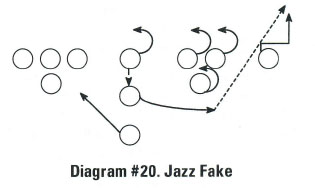| By: Jared Van Acker - Grafton HS (VA)
Originally Published in - Nike 2012 Coach of the Year Clinics Clinic Notes - By Earl Browning
I want to take a minute to let you know who I am. I want to let you know that I do not believe that I know more football than you do. I realize many of you have been coaching football longer than I have lived. This is a small part of who I am. This is an idea that came up for me in my short coaching career. First, I want to tell you I believe we have a great coaching profession of working with young people. We have an opportunity to influence the lives of the players we work with. We must realize that times have changed and the image of football players today is not what it was a few years ago. We cannot treat players like coaches once were able to do. We have a different kind of kid we are working with today. In the game today, we can compare a kid like an apple. They have the hard, glassy-type exterior. They did not want to let us in too much. Often, they want to be that tough guy today. They do not want to let the coaches get close to them. We know inside an apple is the real fruit. I think all kids are fruitful. They are good kids deep down inside. The core of the apple and specifically kids are not rotten to the core today. The impact we have on the kids today is like a seed. The impact we have with them now will bare big dividends in later life. Those seeds may be a tree someday and have more apples. I coached at Galax High School in Virginia. As an assistant, we won the state championship. After that, I was 24 years old when I was named head coach at Galax. I was the youngest head coach in the state of Virginia at the time. I am telling you this so you can see that football has been a big part of my life. I thought I had all of the answers. I expected to win the state championship again. However, I learned early that not everything goes your way. I had to start seven freshmen and sophomores for two years on the varsity level. The one thing that experience did is that it prepared me for where I am today. We took our licks that first year. It prepared me for where I am now at Grafton High School. We have had a lot of success, and a great deal of that comes from the play of our special teams. That is what I want to discuss today. I am going to talk about our loco punt formation. Why the loco punt? That is the first question I am asked about the punt. This is not my information. We are in a coaching profession where we are the best at helping others. We are thieves, but we can't go to jail for stealing our football information. I took this from someone and put my little stamp on it, and I am more than willing to give it out to others.
We are new and innovative. The other teams do not know what is going on. They are scared of what we can do from this formation. It spreads out the defense. We are a spread punt team. The loco punt is similar to the spread offense of today. I switched from the wing-T offense to the spread offense. It opened up a lot of doors for us on offense. Then, I started thinking, and I wanted to know if we could use the same concept with the punting game. We came up with a bunch of fakes off the loco punt. It takes the pressure off the punter. The opponents are afraid we are going to fake the punt. As a result, they are not rushing him as much as they would otherwise. They are not coming after him. The punter can take his time on his punts and put his full effort into the punt, and we can play field position with the opponents. This is crucial with this system. Coaches ask me if we fake the punt on every single punt. No! If we are going to go for the first down, I am going to put my offense out there because I have more faith in my offense. This is our trick configuration to keep the defense on its heels rather than on its toes. I have played against teams that would have all 11 players just stand still when we punted. They just let us punt. The punt allows for successful punt coverage. That is a key for us.
My philosophy has always been this. Defense wins championships. Offense determines by how many points you win the championships. We have never had a team that goes all out to block a punt using the loco. Some teams quit trying to return punts. Some teams will not put anyone back deep because they are so afraid of the fake punt. If we can get the punt off, there will be no YACs—or no yards after the catch. Here is our basic loco punt formation (Diagram #1). Our offensive linemen take four- to five-yard splits. This spreads out the defense. They are scared that they will have to move out with our linemen. What is the shortest and quickest way between two points? It is a straight line. If the defense splits out wide, it is hard for them to get to block a punt. Eventually, the defensive linemen will slide to the gap. That provides us with a perfect down block for our linemen. We have three different formations we use with the loco punt. First is our right formation (Diagram #2). Next is our left formation (Diagram #3). We do have a tight formation as well (Diagram #4). Our philosophy of the loco punt formations is to spread out the return team's numbers. We want to minimize the returns. We want our threat of the fake punt to relieve the pressure on the punter. We use it to gain first-down conversions and to gain field position. I want to cover a few aspects of the punt. There are four areas to consider:
We give each special force a name. They are special teams, so we call them special forces. This adds excitement about the special teams. Most kids want to play offense and score a touchdown. Or they want to play defense. They do not want to play on special teams. We want to make special teams fun and exciting for them. We want to give them some ownership in the special teams. Special Forces - Motivation
We want our kids excited about special teams. I am the head coach, and I am excited about the special teams. I even go out and get the "dog tags" made up for the kids. I put on the tags "Delta Force." If a player does a poor job and has to be replaced, he has to give up his dog tag to the replacement. I have had kids running through the halls waving the dog tags during school. You talk about dedication and pride—this is a good example of how they feel about the dog tags. We are a gap protection team. We count the number of defenders on both sides of the center. We are like a spread offense. We are man-on-man blocking team. We gap-protect on anyone who comes into our lane; we block them. We help out from the inside to the outside. We want to take away that straight line to the punt that the punt rush is looking for. If we count the rushers and have three or four defenders on one side, that is fine. We have eight men to block eight rushers. If they bring five rushers to one side on an overload, we give a lock call or an overload call. The overload call means we take the other up back and block to the five-man side.
If we block on the inside/out protection, we want to use tunnel vision to look straight down the field and block inside to the outside. We make an umbrella out of the line on our blocks. I do want to talk about our punt coverage philosophy. This is our coverage on the punt.
Our base punt is called "Panther." This is how it works. Our loco shifts to the line of scrimmage, and our missile steps back off the line of scrimmage (Diagram #5). Then, he motions across the formation. This comes into play with all of our fakes. How many of you have had a man go into motion when you were punting the football? The coaches on the sideline are yelling to the defense to go with the motion man. To us, this is perfect, and it sets it all up for us. On the motion, the missile settles at the end of the formation on the edge. Then, we snap and punt, and the coverage fans out. We call our loco to the wideside of the field. If we are on the left hash mark, we are calling loco right. If we are on the right hash mark, we call loco left.
We can use this at other times in a game. We may use this just to make sure we get the punt off in order to win the football game. It is used to protect a lead in a game as well. The glorious thing about this punt formation is that we have a ton of fakes on the punt. When you start drawing this punt up, I hope your imagination goes all over the place. I have at least 15 things we can do on the fake punt. All of those things must come by way of the defense. How are they playing us? We have five eligible receivers counting the two wideouts, the loco, and the two up backs. Step #1: How do they cover the loco plus other eligible wide receivers? Step #2: How do they respond to the motion of the missile? Falcons = Fake punt audible We want to know how the defense covers the motion (Diagram #7). Some teams go with the motion; others do not. Some teams may rotate the secondary.
I have had other coaches tell me they spent hours practicing to stop our punt team. If they are spending time to stop our punt team, it means they are not spending time in stopping our offense or attacking our defense. This should give us an edge—one way or the other. Our fake punt audible is falcon. It depends on what the defense does as to when we run it and how we use it.
All of our fake punts are named after NFL teams, and our PAT kick conversions are named after NBA teams. It is just another way to help kids remember things. We also use Elmer Fudd. How many of you know who he is? In football, Elmer Fudd is the player who can't play dead in a cowboy show. Elmer Fudd is the kid who has two different color socks on, and one of them is high and the other is low. He has the thick goggles under his helmet. You know your athlete is better than Elmer Fudd. Our best player is our loco. The defense better have its best defender on our loco. If they do not have their best player on our loco, we are going to use that mismatch against you. We try to find that Elmer Fudd on defense, and we go at him. The punter reads the corner on the play. We have been blessed in that I like to have my best passer as the punter. It is usually the quarterback. I have run the system where we did not have a quarterback in the punter's position. If we do not have a quarterback as a punter, all we have to do is to teach the punter to throw a five-yard out route. We expect to get a five-yard out route with the loco. The corner chases the gunner downfield. That leaves the loco 1-on-1 on the out route, and he should be able to make the play since he is out best athlete. We have had teams that see us running this play, and they go tackle the loco as soon as the play starts out. That is interference, and we get a first down. As a teacher, I know that kids learn in different ways. As a teacher, I have to know how the football players learn. Some people learn by visuals, and some learn by audio. That is the reason we show film, and we go over things on and off the field.
If the corner does not go with the motion, we call Steelers (Diagram #10). We run the sweep to the weakside and have a big advantage.
Now we have a numbers advantage if the defense does not go with the motion. It gives us a sweep to the strength of our formation. The punter takes the ball and heads for the outside as hard as he can go. We have the loco and two up backs leading the way. You can put the loco to the shortside of the field and motion him back to the wideside and run the sweep to the wideside. This is how you game plan and study the opponents from week to week. We can change things up each week. Our rules are not set in stone.
Our middle screen is called our Seahawks. We use this if teams are going for an all-out block. We take advantage of the rush. I ran this play for the first time in a game this year. It was wide open. We snap the ball to the punter. The up backs both swing outside (Diagram #12). The loco comes back across the middle, and the punter throws him the ball. If we face a team that likes to set up a punt return on us, we use our fake punt packer. It is a called option pass fake. We snap the ball to the left up back. He is going to be the quarterback on the play (Diagram #13). The right up back leads the option play to the outside. The up back pitches the ball to the punter off the first In the short amount of time I have left, I want to talk about our muddle huddle and more specifically our two-point plays on the point after touchdown or a fake field goal. Last year, I spoke at a special teams clinic in Shenandoah, Virginia. Abe Mikell ran the clinic and asked me to speak on the loco punt. I stayed around and listened to other speakers on special teams. Coach Mikell gave a lecture on the muddle huddle. After he spoke, I visited with him. I was intrigued by his lecture. The first question I have to answer is: why the muddle huddle?
I studied the spread offense with a coach that played under Rich Rodriguez when he was at Glenville State College. He knew the spread option game from the spread offense they ran at Glenville State. I learned about schemes from him. I learned about the number of defenders in a box. How many players are in the box? Do they have four players to cover our four players? If we spread out and take big splits, what does this do to the defense? The defense widens with the splits. What did you do to create plays? They used the spread to open up the running game.
As a result of what I learned about the spread game, I use those weapons for my special teams. It is the same theory. I use the spread offensive philosophy with the special teams. We use it on all phases of our special teams. We use spread offensive elements with our special teams. Good football teams will force you to earn the two-point conversion. The weak teams may do nothing special to prepare for your muddle huddle and let you do what you want on the play. Most teams are going to try to figure out what you trying to accomplish and try to stop you. The basic formation of the muddle huddle separates the formation into four pod groupings (Diagram 14). Pod #1 The first pod incorporates four players, two of which are eligible receivers. You will want one of your better skill players as the player behind the wall/bunch. He can be used as a wide receiver, running back, and even as a quarterback. Pod #2 The second pod incorporates your long snapper, holder, and kicker. The kicker places the kicking tee at the desired depth—for us, it's six to seven yards deep—and stands at that depth. We count the numbers on the defense from left to right. Your long snapper must be very good and be able to shotgun snap, PAT snap, and snap horizontally to each of the two up backs on both sides. He cannot stand up and throw the ball to the backs outside. He has to underhand the ball outside or pitch it with both hands from the bent-knee position. Pod #3 The third pod consists of three players, with one being an up back who is another one of our best skill players who can be used as a wide receiver, a running back, and even as a quarterback. Pod #4 The fourth and last pod consists of one player and is usually your best athlete. We put our all-state 6'5", 230-pound tight end/wide receiver out there by himself, which causes serious 1-on-1 mismatches for our opponents. During pre-practice special teams segment, our snapper will get up backs, the holder, the kicker, and wide receivers together and run all snaps (Diagram #15). This past year, we were 9 for 11 on two-point conversions. We had one bad snap, and on the other miss, the passer did not count the defense correctly, and as a result, the receiver was not open. We want the pod #4 man to be out on the numbers. I put him on the numbers so he has room. We run individual routes with him. We throw a slant, a comeback, a hitch, and a fade route with him. We can run any pattern with him. We have 15 fakes on this play. We practice every single one of those plays. If the defense is coming inside on the rush, we want to go outside. You check the advantages you have when you line up and take advantage of the things the defense gives you. Everything we run is no-huddle. That is offense, defense, and special teams. The no-huddle call system usually is called or determined by the number of defenders in our pod zones. Our holder reads or counts the number of defenders in each pod zone from left to right, looking for numbers, skill, or size mismatch advantages that we can exploit. When it is determined that we want to kick the PAT, our holder will audible to shift (Diagram #16). Our pods then shift or converge in typical field goal/ extra point formation.
When it is determined that we want to fake and there is a numbers advantage in pod #3, we run our Rockets fake (Diagram #18). The snapper makes a direct snap/rugby-style pass to the right up back. The right up back audibles to the wall of blockers in front of him the direction he will be going: out, in, or middle. The wide receiver in pod #4 communicates (via hand signal) what route he will run based on the alignment of the defender: slant, pylon, fade, pigtail, jump ball, comeback, etc. The possibilities are endless. Let your creativity flow! I have over 15 fakes and counting. I hope to have a couple of new wrinkles for 2012.
If you have questions, let me know. My email is Jvanacker@ycsd.york.va.us. Feel free to call me or send me a note, and I will be glad to send you what we do.
|
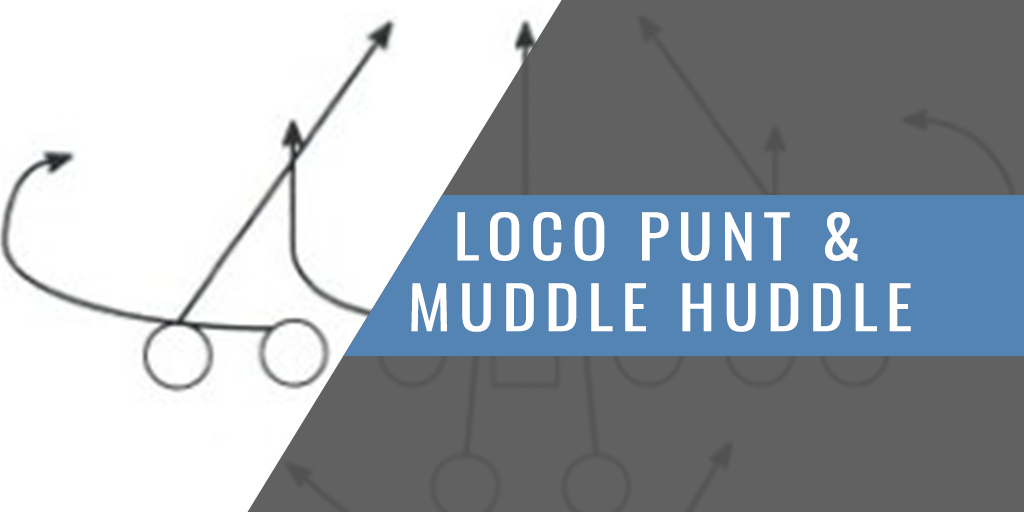


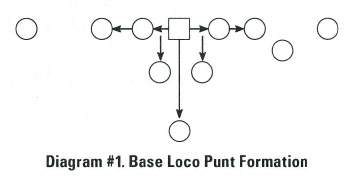
 We have only had two punts blocked in five years of running the loco. Those two blocks happened because of poor execution.
We have only had two punts blocked in five years of running the loco. Those two blocks happened because of poor execution.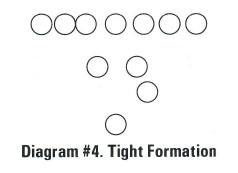
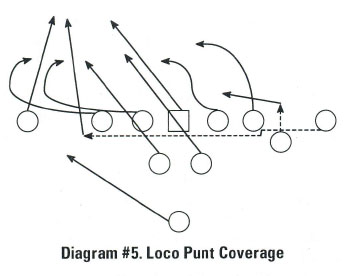 That leaves us with a 3-on-3 on the backside. If the center is good enough to make the snap and steps to the A gap on the five-man side, we call lock and the center picks up the A gap defender. If the center is not that good, we do not want to put a lot of pressure on him, so we call overload.
That leaves us with a 3-on-3 on the backside. If the center is good enough to make the snap and steps to the A gap on the five-man side, we call lock and the center picks up the A gap defender. If the center is not that good, we do not want to put a lot of pressure on him, so we call overload.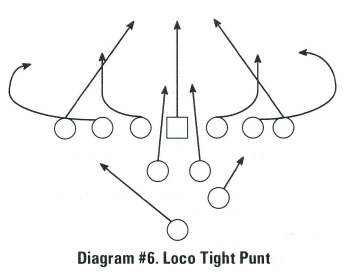 What do spread punt teams do when they get backed up inside their five-yard line and have to punt? They bring everyone inside and block down. The thing that matters is to get the punt out of the end zone. We have the same component in our loco system, and we call it tight loco punt (Diagram #6). We bring the two outside missiles in tight, and we line up with small splits in the line. We bring the wing back behind the up back in a blocking position. We use this when we are backed up in our own end zone. We do have this just in case we do have to use this type of punt.
What do spread punt teams do when they get backed up inside their five-yard line and have to punt? They bring everyone inside and block down. The thing that matters is to get the punt out of the end zone. We have the same component in our loco system, and we call it tight loco punt (Diagram #6). We bring the two outside missiles in tight, and we line up with small splits in the line. We bring the wing back behind the up back in a blocking position. We use this when we are backed up in our own end zone. We do have this just in case we do have to use this type of punt.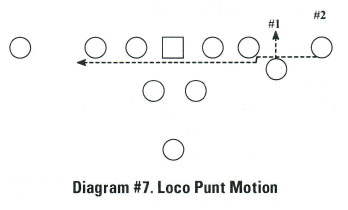 We are a no-huddle offense, defense, and special teams. You must be ready to play when we play. We are like the University of Oregon Ducks in that respect of the game.
We are a no-huddle offense, defense, and special teams. You must be ready to play when we play. We are like the University of Oregon Ducks in that respect of the game.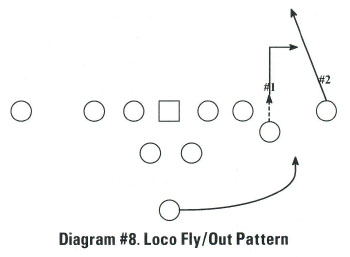
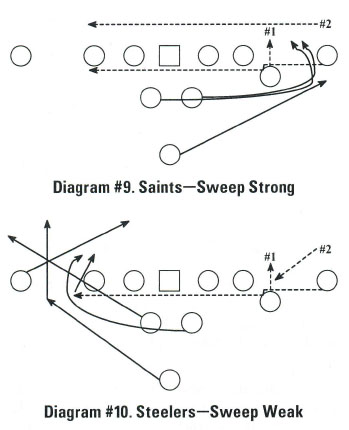 If we call Saints, it is our sweep to our strongside. You must remember the strongside is to the wideside of the field. If the corner goes with the missile in motion, he has opened up about one-third of the football field on the backside. There is no on over there (Diagram #9). We can snap the ball to the punter and run our zone sweep play to the vacated area. We tell the punter to run for the numbers.
If we call Saints, it is our sweep to our strongside. You must remember the strongside is to the wideside of the field. If the corner goes with the missile in motion, he has opened up about one-third of the football field on the backside. There is no on over there (Diagram #9). We can snap the ball to the punter and run our zone sweep play to the vacated area. We tell the punter to run for the numbers.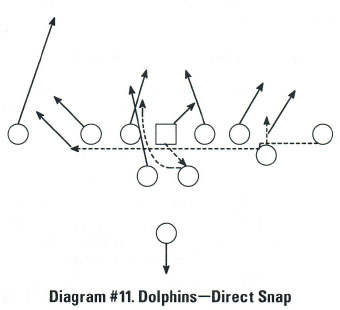 If we want to run the ball with one of the up backs, we make a direct snap to one of them (Diagram #11). The other up back becomes a lead blocker on the play. It is our Dolphins call. Some teams run this play with trap blocking.
If we want to run the ball with one of the up backs, we make a direct snap to one of them (Diagram #11). The other up back becomes a lead blocker on the play. It is our Dolphins call. Some teams run this play with trap blocking.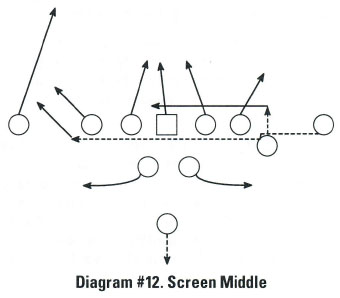 defender to show. The punter has the option to throw a pass to the crossing missile on a drag route. He can run the ball if he sees daylight. He can punt the ball if he sees his way clear.
defender to show. The punter has the option to throw a pass to the crossing missile on a drag route. He can run the ball if he sees daylight. He can punt the ball if he sees his way clear.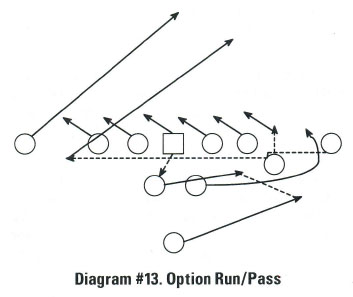
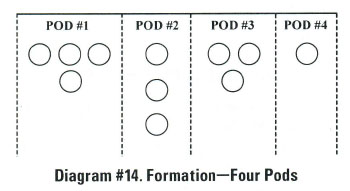
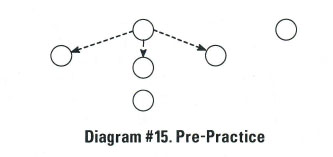

 We align on the kick the same as any other team would on the kick for a field goal or extra point. When it is determined that we want to fake and there is a numbers advantage in pod #1, we run our Lakers fake (Diagram #17). When the up back on the left hears Lakers, he knows he is going to get the ball. The snapper makes a direct snap/rugby-style pass to the left up back. The left up back audibles to the wall of blockers in front of him what direction he will be going: out, in, or middle.
We align on the kick the same as any other team would on the kick for a field goal or extra point. When it is determined that we want to fake and there is a numbers advantage in pod #1, we run our Lakers fake (Diagram #17). When the up back on the left hears Lakers, he knows he is going to get the ball. The snapper makes a direct snap/rugby-style pass to the left up back. The left up back audibles to the wall of blockers in front of him what direction he will be going: out, in, or middle.
